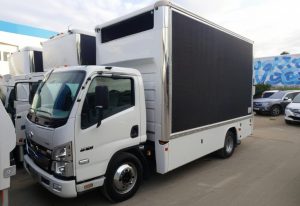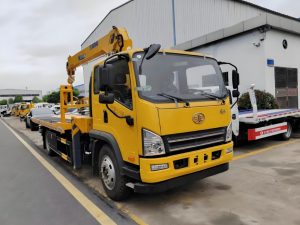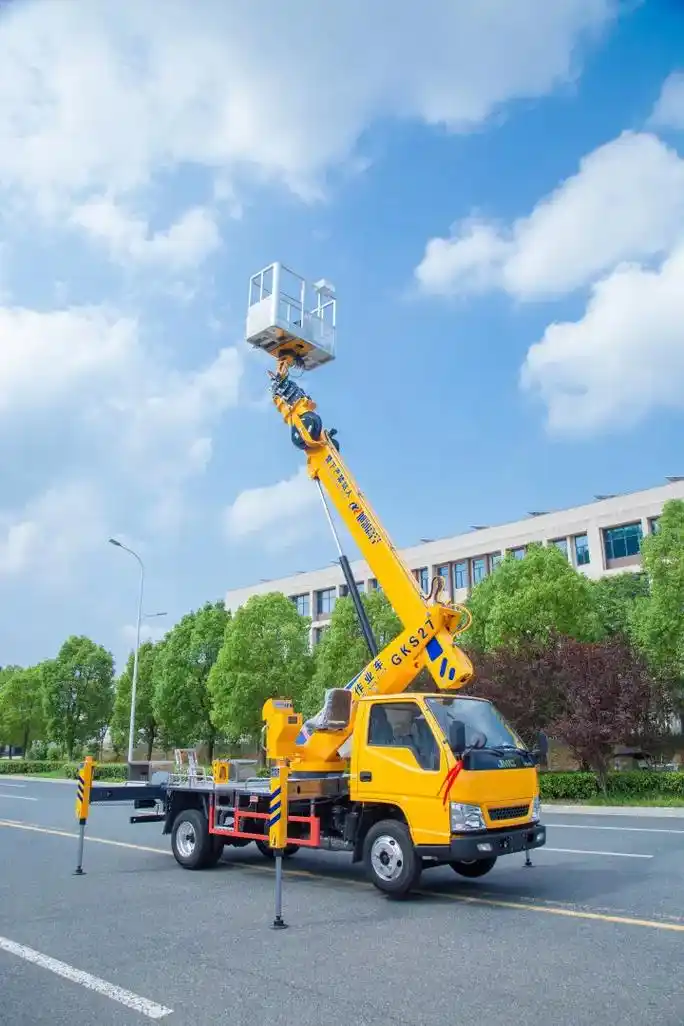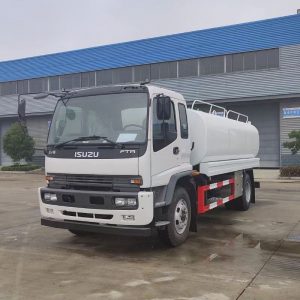Table of Contents
Toggle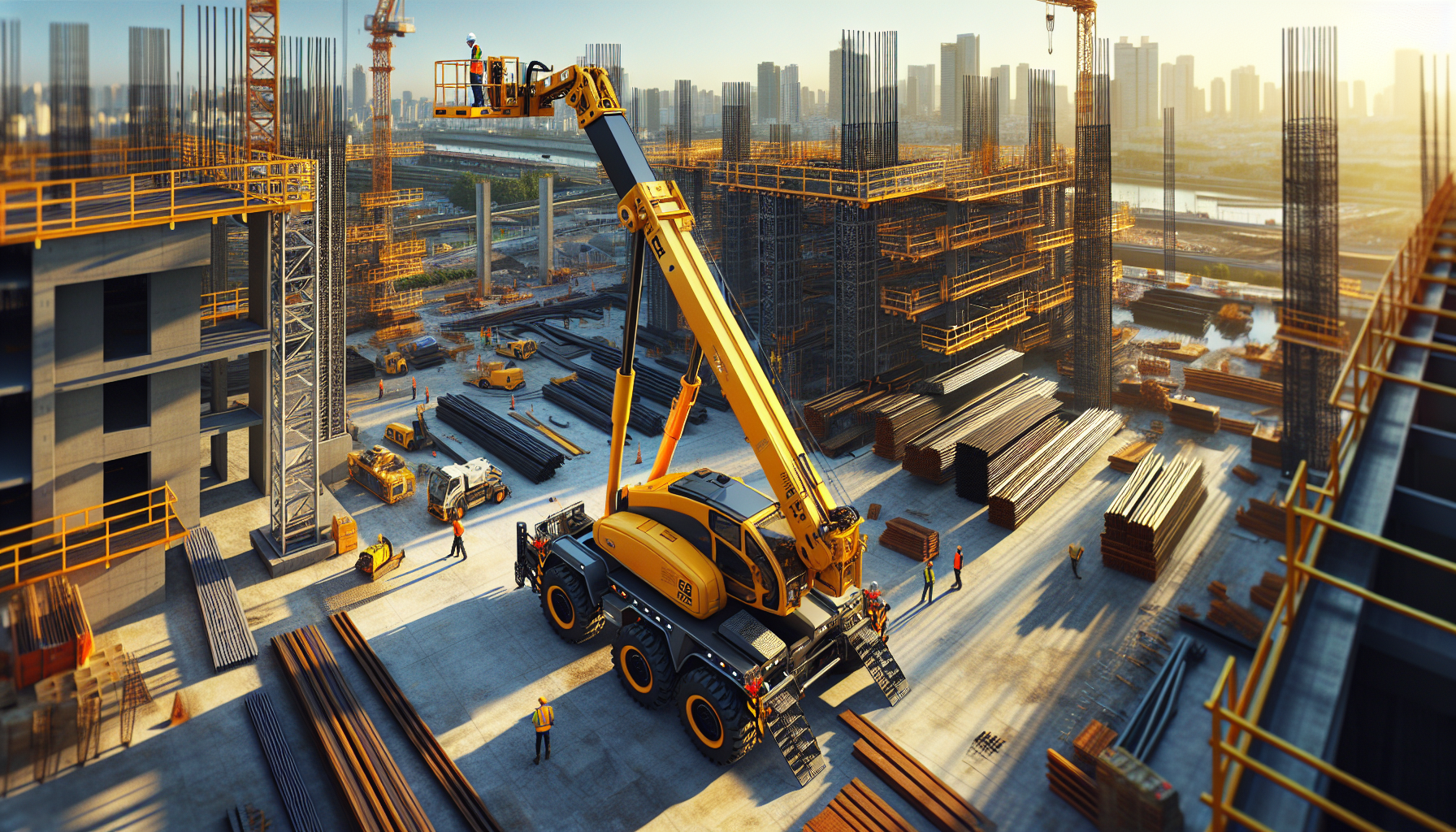
Aerial platform trucks are revolutionizing the firefighting industry, offering unprecedented access to high-rise buildings and challenging terrain. These specialized vehicles combine the functionality of a traditional fire truck with an extendable boom and platform, providing firefighters with a versatile tool for rescue operations and fire suppression. As cities grow taller and emergencies become more complex, the demand for these advanced machines continues to rise.
This article delves into the world of aerial platform trucks, exploring their various types, key features, and top manufacturers. It examines performance metrics that matter most in real-world scenarios and discusses crucial safety considerations for operators. Additionally, the piece covers practical applications, maintenance requirements, and longevity factors to help readers make informed decisions when considering these essential firefighting assets. Whether you’re a fire department official or simply curious about these impressive machines, this comprehensive guide has you covered.
Types of Aerial Platform Trucks
Aerial platform trucks come in various configurations to meet the diverse needs of firefighting and rescue operations. These specialized vehicles offer unique advantages depending on their design and power source. Understanding the different types helps fire departments make informed decisions when selecting the most suitable equipment for their specific requirements.
Articulated vs. Telescopic
Articulating boom lifts and telescopic boom lifts are two primary categories of aerial platform trucks, each with distinct characteristics and applications.
Articulating boom lifts, also known as knuckle booms, feature a segmented arm with multiple joints, typically two or three. This design allows for exceptional maneuverability, enabling firefighters to reach difficult-to-access locations. With a 360-degree base turntable, these lifts can swivel in any direction, offering unparalleled flexibility. Articulating booms have an impressive reach of up to 150 feet, making them ideal for navigating around obstacles such as ceiling joists, roofs, and warehouse shelves.
Telescopic boom lifts, on the other hand, lack joints but can extend straight up or at an angle, similar to a telescope. These lifts offer an extended outreach, sometimes surpassing that of articulating lifts, with some models reaching up to 210 feet. Telescopic booms excel in scenarios requiring higher vertical and horizontal reach, making them suitable for tasks like building bridges or working on skyscrapers.
| Feature | Articulating Boom Lifts | Telescopic Boom Lifts |
|---|---|---|
| Design | Segmented arm with joints | Straight extendable arm |
| Max Reach | Up to 150 feet | Up to 210 feet |
| Maneuverability | High in tight spaces | Limited in confined areas |
| Best Use | Indoor work, navigating obstacles | Outdoor work, high-reach tasks |
Electric vs. Diesel
The choice between electric and diesel-powered aerial platform trucks depends largely on the intended work environment and operational requirements.
Electric lifts run on batteries, making them ideal for indoor use. They produce zero emissions and operate quietly, minimizing disruption in enclosed spaces. These lifts are perfect for warehouses, public buildings, and other indoor environments where air quality and noise levels are concerns. Recent advancements in battery technology have improved their runtime, although they still have limitations compared to diesel models.
Diesel lifts, conversely, are better suited for outdoor applications. They typically offer longer runtimes and more power, making them capable of handling rough terrain and adverse weather conditions. Diesel engines provide the necessary strength for larger models, with telescopic lifts ranging from 40 to 185 feet and articulating lifts from 34 to 150 feet. However, their emissions and noise levels make them less suitable for indoor use.
Compact vs. Heavy-Duty
Aerial platform trucks also vary in size and capacity, ranging from compact models for tight spaces to heavy-duty units for demanding tasks.
Compact lifts are designed for maneuverability in confined areas. These smaller units, often electric-powered, are ideal for indoor work in warehouses, maintenance tasks, and areas with limited access. They can navigate narrow aisles and doorways, making them versatile for a variety of indoor applications.
Heavy-duty lifts, typically diesel-powered, are built for challenging outdoor environments. These larger units have higher weight capacities, allowing them to carry more equipment and personnel. They’re equipped with features like all-terrain tires and stabilizers for use on uneven surfaces. Heavy-duty lifts are essential for construction sites, large-scale firefighting operations, and industrial applications where power and reach are paramount.
Choosing the right type of aerial platform truck involves considering factors such as work environment, required reach, power source, and specific operational needs. By understanding these various types, fire departments and rescue teams can select the most appropriate equipment to enhance their capabilities and ensure effective emergency response.
Key Features to Consider
When evaluating aerial platform trucks, several critical features demand attention to ensure optimal performance and safety. These features play a crucial role in determining the truck’s suitability for specific tasks and environments.
Platform Size and Capacity
The platform, or elevated platform, is a key component of an aerial device. It serves as the personnel-carrying device, typically in the form of a basket or bucket. The platform’s size and capacity directly impact the truck’s functionality and safety.
Platform capacity specifies the maximum weight the bucket or platform can safely hold. It’s essential to choose a bucket truck with an adequate platform capacity to accommodate workers, tools, and materials. Most platforms have a rated capacity of 1,000 pounds when dry, with a minimum rating of 750 pounds. However, when flowing water, the capacity is often reduced by 50% due to nozzle reaction forces.
Working Height and Outreach
Working height refers to the maximum vertical reach of the bucket truck, including the height of the truck chassis and the extension of the boom. This specification is crucial for tasks requiring access to greater heights, such as maintenance of tall structures or firefighting in high-rise buildings.
Horizontal outreach is equally important, as it determines the distance the boom can extend horizontally from the center of the vehicle. This feature is particularly valuable when working on tasks that require reaching over obstacles or accessing areas not directly below the truck.
Stabilization System
The stabilization system is critical for maintaining the truck’s proper position during aerial operations. Several types of stabilizing systems are used:
- A-frame (X-style): Extends outward at a downward angle
- H-style: Extends horizontally, then down to the ground
- Gull wing: Stored vertically and deploys downward
- Under-slung: Part of the apparatus torque box, extends horizontally then down
The H-style stabilizer offers several advantages:
- Higher strength-to-weight ratio, allowing for lighter materials
- Independent deployment of each stabilizer
- Safe and effective short-jacking capabilities
- 18 inches of ground penetration for improved leveling on uneven terrain
Controls and Safety Features
Modern aerial platform trucks come equipped with advanced control systems and safety features to enhance operational efficiency and protect workers.
- Envelope Control: Some telescopic and articulated boom platforms use envelope control to provide a safe operating range. This system integrates sensors that determine position, load, outrigger stance, and wind conditions to adjust the platform’s range of motion.
- Load Charts and Displays: Located near the platform control console and at the turntable operator’s position, these charts are critical for safe operations and effective performance.
- Joystick Controls: Many trucks feature joysticks with ramping characteristics that smooth out abrupt starts and stops. However, these features may vary between manufacturers and models.
- Platform Speed Control: Some systems adjust platform speeds based on aerial position to ensure safe operation at various heights and angles.
- Stabilizer Placement Assistance: Features like cameras and laser beams help operators accurately place stabilizers, especially in challenging environments.
- Automatic Leveling Systems: These systems can automatically level the stabilizers to the proper operating position, saving crucial time during emergencies.
By carefully considering these key features, fire departments and rescue teams can select the most appropriate aerial platform truck to enhance their capabilities and ensure effective emergency response.
Top Manufacturers and Models
The aerial platform truck market boasts several leading manufacturers, each offering unique features and capabilities. This section explores some of the top brands and their standout models, highlighting the innovations that set them apart in the industry.
Pierce Aerial Platforms
Pierce Manufacturing has established itself as a prominent player in the fire apparatus industry, known for its Ascendant class of aerials. These vehicles have been designed to address the specific needs of fire departments, offering heavy-duty capabilities and dependability.
The Ascendant class features:
- Increased tip-loads and water flow
- Superior extension, including vertical, horizontal, and below-grade reach
- Lower cost of ownership
- Improved rescue capabilities
- Heavy-duty 100K psi high-strength steel design
- Reduced overall vehicle weight
One of Pierce’s notable models is the Ascendant 100′ Heavy-Duty Aerial Tower. This mid-mounted aerial offers unmatched maneuverability, drivability, operability, and serviceability. Another impressive model is the Ascendant 107′ Single Axle Heavy-Duty Aerial Ladder, which has redefined the single rear axle aerial market without compromising on water capacity, performance, or safety.
E-ONE Aerial Platforms
E-ONE has made a name for itself with its innovative aluminum aerials, offering a commitment to safety that exceeds industry standards. Their aerials feature a 2.5 to 1 structural safety factor, surpassing the NFPA’s 1901 requirements.
Key E-ONE models include:
- HP 75: Features an extruded aluminum ladder that won’t rust, never needs painting, and doesn’t require rung cover replacements.
- HP 78: Offers an 825-lb tip load for increased rescue capability and additional reach compared to similar products in its class.
- Metro 100: A single axle, low travel height, aluminum ladder with a 100′ vertical reach, designed for both urban and suburban departments.
- HP 100 Platform: Provides a 100′ vertical reach and 91’6″ horizontal reach while offering a 2.5 to 1 structural safety factor.
E-ONE’s aerials are known for their quick set-up times, with some models deploying in less than 40 seconds, making them ideal for rapid response in tight urban environments.
Socage Aerial Platforms
Socage specializes in aerial work platforms with a focus on innovation and versatility. Their forSte 27D SPEED model exemplifies their commitment to high performance and user-friendly design.
Key features of Socage platforms include:
- Automatic stabilization systems
- High working heights (up to 27m for the forSte 27D SPEED)
- Significant lateral reach
- Smooth and proportional movements with greater operator control
Socage also offers a range of platforms on crawlers, pick-up trucks, and vans, catering to various needs and environments. Their designs focus on allowing large work areas without limitations, with maximum range of the basket.
Alké Electric Aerial Platforms
Alké stands out in the market with its focus on electric aerial work platforms, catering to environmentally conscious operations and indoor work environments. Their platforms are designed for versatility and compact maneuverability.
Notable features of Alké platforms include:
- Four independently controlled stabilizing feet for optimal positioning
- Compact design suitable for narrow passageways
- Easy and intuitive proportional commands within the elevating basket
- Suitability for both indoor and outdoor operations
- Approval for road circulation
Alké’s aerial platforms are particularly popular for city maintenance, public lighting work, and shopping center operations, where a single vehicle can handle both indoor and outdoor tasks efficiently.
In conclusion, these manufacturers represent the cutting edge of aerial platform truck technology, each bringing unique strengths to the market. From Pierce’s heavy-duty capabilities to E-ONE’s safety-focused designs, Socage’s versatility, and Alké’s eco-friendly electric options, fire departments and other users have a wide range of choices to meet their specific operational needs.
Performance Metrics
When evaluating aerial platform trucks, several key performance metrics play a crucial role in determining their effectiveness and safety in various operational scenarios. These metrics help fire departments and operators assess the capabilities and limitations of these specialized vehicles.
Flow Capacity
The flow capacity of an aerial platform truck is a critical factor in firefighting operations. It refers to the amount of water or other firefighting agents that can be delivered through the aerial device. Most platforms have a rated capacity when dry and a separate rating when flowing water. The minimum dry capacity rating for a platform is 750 pounds, but many platforms are rated for 1,000 pounds. However, when water is flowing, platform ratings are commonly reduced by 50 percent due to nozzle reaction forces.
Understanding the flow capacity is essential for effective firefighting strategies. Operators must be aware of these ratings and adjust their tactics accordingly to maintain safety and maximize the platform’s effectiveness during water flow operations.
Payload Capacity
Payload capacity is a crucial performance metric for aerial platform trucks. It refers to the maximum weight a vehicle can safely carry, including personnel, equipment, and tools. A large payload capacity is particularly important for aerial platforms mounted on vehicles, as it allows operators to transport all necessary tools and equipment for their work.
Recent trends in the industry have focused on increasing payload capacity:
- Lightweight Materials: Manufacturers are increasingly adopting lightweight materials to enhance fuel efficiency and payload capacity. This allows for more equipment to be carried without compromising the vehicle’s performance or safety.
- Advanced Technologies: The integration of IoT (Internet of Things) and telematics has enabled more precise monitoring of payload capacity. These technologies help operators ensure they’re operating within safe limits and can optimize load distribution.
- Electric-Powered Platforms: There’s a rising demand for electric-powered aerial work platform trucks due to environmental concerns and stringent emission regulations. These vehicles often offer different payload characteristics compared to their diesel counterparts.
It’s crucial for operators to understand and adhere to payload capacity limits. Exceeding these limits can compromise the stability and safety of the aerial platform, potentially leading to accidents or equipment failure.
Wind and Ice Ratings
Wind and ice conditions significantly impact the performance and safety of aerial platform trucks. Manufacturers provide specific ratings and guidelines for operation in these challenging environments.
Wind Ratings:
- Most manufacturers recommend not using aerial devices when wind speeds exceed 35 mph.
- Some manufacturers set this limit between 35 to 50 mph.
- OSHA regulations state that aerial lifts should not be operated in winds over 20 mph.
Wind effects on aerial platforms:
- Load center shift when wind blows from behind
- Increased turning radius and decreased lifting capacity
- Side load on the lift when wind blows from the side
- Wind tunnel effect between structures, potentially increasing wind velocity
Ice Ratings:
- Ice accumulation on an aerial device can add weight, reducing its rated capacity.
- Manufacturers account for potential ice buildup in their designs, often stating the magnitude of ice buildup accounted for in the design and load charts.
- Operating on compacted snow or ice can be dangerous due to potential melting and instability.
To ensure safe operation in cold weather:
- Refer to the user’s manual for de-icing procedures
- Keep the aerial ladder greased according to manufacturer specifications
- Continuously monitor stability when operating on snow or ice
Understanding and adhering to these wind and ice ratings is crucial for safe operation of aerial platform trucks in various weather conditions. Operators must be trained to recognize when environmental conditions exceed safe operating parameters and take appropriate action to ensure the safety of personnel and equipment.
Safety Considerations
Aerial platform trucks are powerful and complex machines that require careful operation and maintenance to ensure the safety of firefighters and rescue personnel. Manufacturers and industry organizations have developed comprehensive guidelines and technologies to address potential hazards and promote safe practices.
Basket Design
The platform, or basket, is a critical component of aerial devices. It serves as the personnel-carrying device and must meet stringent safety standards. Most platforms have a rated capacity of 1,000 pounds when dry, with a minimum rating of 750 pounds. However, when water is flowing, platform ratings are commonly reduced by 50 percent due to nozzle reaction forces. This reduction in capacity highlights the importance of operators understanding and adhering to load limits during firefighting operations.
To enhance safety, modern platforms are equipped with guardrails and gates. These features must be free from cracked welds or missing parts. Swinging gates are designed to only swing inward, preventing accidental openings that could lead to falls. Additionally, the use of personal protective equipment (PPE) is crucial when working on an aerial device. This includes a ladder belt or safety harness that complies with NFPA 1983, Standard on Life Safety Rope and Equipment for Emergency Services. The tether for these safety devices cannot exceed 24 inches, ensuring that firefighters remain securely attached to the platform.
Emergency Controls
Aerial platform trucks are equipped with two sets of controls: lower level controls on the body of the lift and upper level controls on the platform itself. This dual-control system allows for operation from both the ground and the platform, providing flexibility and redundancy in emergency situations.
Key safety features of the control systems include:
- Emergency stop buttons at both lower and upper levels
- Two-hand control systems or foot pedals to prevent inadvertent movement
- Selector switches to transfer control between ground and platform operators
Operators must test all controls before each use to ensure proper functionality. This includes verifying the operation of lifting, lowering, and maneuvering controls, as well as driving and steering functions for mobile units. The ability to stop all movement immediately using emergency stop buttons is crucial for preventing accidents in rapidly changing situations.
Stabilizer Technology
One of the most critical systems on aerial apparatus is the stabilization system. These jacks or outriggers keep the truck in its proper vertical position during aerial operations. Several types of stabilizing systems are used, including:
- A-frame (X-style): Extends outward at a downward angle
- H-style: Extends horizontally, then down to the ground
- Gull wing: Stored vertically and deploys downward
- Under-slung: Part of the apparatus torque box, extends horizontally then down
The H-style stabilizer system offers several advantages, including a higher strength-to-weight ratio, independent deployment of each stabilizer, and safe short-jacking capabilities. Short jacking, which involves not fully extending stabilizers on one side due to obstacles, requires advanced safety systems to prevent overturning. Manufacturers like Rosenbauer and KME have developed smart systems that monitor the aerial device’s active loading in real-time and prevent operators from extending the ladder or platform beyond safe limits.
To assist operators in safely deploying stabilizers, manufacturers have introduced innovative technologies:
- Laser-guided placement systems: Project the footprint of the stabilizer onto the ground
- Stabilizer placement cameras: Show the outline of the stabilizer in the camera view
- Automatic leveling systems: Adjust stabilizers to achieve proper operating position
These advancements in stabilizer technology significantly enhance the safety and efficiency of aerial platform truck operations, particularly in challenging urban environments with narrow streets and obstructions.
Applications and Use Cases
Aerial platform trucks are versatile machines with a wide range of applications across various industries. Their ability to provide safe and efficient access to elevated work areas makes them indispensable in numerous scenarios.
Fire Fighting
In urban environments, aerial platform trucks play a crucial role in firefighting operations. The prevalence of high-rise and multi-occupancy buildings presents unique challenges that these specialized vehicles are designed to address. Although high-rise fires are infrequent, they are labor-intensive events that require special tactics, tools, and knowledge.
Aerial platforms offer firefighters several advantages:
- Elevated water delivery: With the ability to reach heights of up to 100 feet, these trucks can deliver water streams directly to upper floors of burning buildings.
- Rescue operations: The large platforms can safely evacuate multiple individuals from high-rise structures, particularly beneficial in hospitals and retirement facilities.
- Ventilation access: Firefighters can quickly access rooflines for ventilation purposes, improving overall firefighting efficiency.
The Mumbai Fire Brigade in India utilizes aerial platforms with flexible cage designs, allowing for safe operations even at heights of 260 feet. These platforms can accommodate emergency medical professionals alongside rescue personnel, enhancing the effectiveness of rescue missions.
Urban Maintenance
Aerial platform trucks are essential for various urban maintenance tasks. Their versatility allows workers to access hard-to-reach areas safely and efficiently. Common applications include:
- Streetlight repairs and maintenance
- Installation and maintenance of signage
- Painting and cleaning of tall structures
- Tree trimming and landscaping
The compact design of some aerial platforms, such as atrium lifts, allows them to fit through standard double doorways, making them ideal for indoor maintenance in large spaces like libraries, gymnasiums, and atriums.
Construction and Industrial Use
In the construction and industrial sectors, aerial platform trucks offer numerous benefits:
- Building maintenance: Workers can easily access building facades for repairs, window installations, and cleaning.
- Electrical work: Telescopic boom lifts are commonly used for accessing power lines, transformers, and other high-elevation electrical equipment.
- Mining operations: Scissor lifts are utilized in smaller tunnels and shafts for various mining activities.
- Manufacturing facilities: From paper mills to food production plants, aerial platforms provide access for maintenance and repairs in large industrial settings.
| Industry | Common Applications |
|---|---|
| Construction | Building facade work, window installation, structural repairs |
| Electrical | Power line maintenance, transformer access, conduit routing |
| Manufacturing | Equipment maintenance, high-bay lighting repairs |
| Mining | Tunnel and shaft access, equipment installation |
The versatility of aerial platform trucks makes them invaluable across these diverse applications. Their ability to provide safe, elevated access while accommodating workers, tools, and equipment has revolutionized operations in firefighting, urban maintenance, and industrial sectors.
Maintenance and Longevity
Maintaining aerial platform trucks is crucial for ensuring their longevity, safety, and optimal performance. Proper maintenance not only enhances productivity but also contributes to financial control and streamlined operations. By implementing a comprehensive maintenance plan, operators can expect several benefits, including reduced repair costs, extended service life, and maximized value of their equipment.
Structural Warranties
Manufacturers often provide warranties to guarantee the structural integrity of their aerial platform trucks. For instance, MEC Aerial Platform Sales Corp. offers a five-year warranty on structural weldments of the main frame and scissor arms, covering defects in material or workmanship. Similarly, Sutphen Corporation provides a ten-year warranty on body structural integrity for their apparatus bodies and heavy-duty rescue bodies.
These warranties typically cover repairs or replacements of defective parts, with some manufacturers offering pro-rated coverage. For example, Sutphen’s warranty is pro-rated over ten years, with 100% coverage for the first five years, decreasing to 25% in the ninth and tenth years.
Servicing Requirements
Regular servicing is essential to maintain the performance and safety of aerial platform trucks. Manufacturers recommend following a prescribed preventative maintenance schedule based on operating hours. ANSI (American National Standards Institute) standards require:
- Annual inspections every 13 months
- Pre-start and intermittent inspections
- Inspections every three months or 150 hours of use
Key components that require inspection during annual checks include:
- Visual inspection
- Acoustic Emissions (AE) test
- Magnetic particle inspection
- Dye penetrant inspection
- Ultrasonic inspection
- Torque testing
- Functional and operational testing
- Dielectric testing (where applicable)
For electric models, maintenance requirements vary depending on the battery type. Sealed lead acid and lithium-ion batteries have specific guidelines for charging and storage to maximize battery life. It’s crucial to follow manufacturer recommendations for optimal performance and longevity.
Refurbishment Options
As aerial platform trucks age, refurbishment becomes an option to extend their service life. This process can involve:
- Repainting: Manufacturers like MEC Aerials offer paint surface finish warranties, covering defects in materials and workmanship for up to two years.
- Undercoating: Some manufacturers, such as Sutphen, recommend periodic undercoating inspections and touch-ups to prevent rust and maintain structural integrity.
- Component replacement: Replacing worn parts with new ones can significantly extend the life of the equipment.
- System upgrades: Updating control systems or safety features can bring older models up to current standards.
Proper documentation of all maintenance activities is crucial for warranty claims, anticipating future repair needs, and supporting legal cases if workplace incidents occur. Many businesses now rely on equipment maintenance software to track servicing activities, schedule upcoming maintenance, and plan for downtime and associated costs.
By adhering to these maintenance practices and exploring refurbishment options when necessary, operators can significantly extend the lifespan of their aerial platform trucks, reduce downtime, and ensure optimal performance throughout the equipment’s service life.
Conclusion
Aerial platform trucks have a significant impact on firefighting, urban maintenance, and industrial operations. These versatile machines offer safe and efficient access to elevated work areas, revolutionizing how tasks are performed in various sectors. From battling high-rise fires to maintaining streetlights and performing construction work, these trucks have become indispensable tools for many professionals. Their ability to adapt to different environments and tasks makes them a valuable asset in today’s urban landscape.
To keep these crucial machines running smoothly, regular maintenance and proper care are essential. By sticking to manufacturer-recommended service schedules and exploring refurbishment options when needed, operators can extend the lifespan of their equipment and ensure optimal performance. This approach not only enhances safety but also leads to cost savings in the long run. As cities continue to grow taller and more complex, the role of aerial platform trucks in maintaining urban infrastructure and responding to emergencies will only become more crucial.


